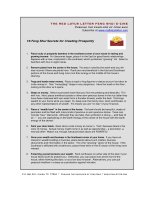5 guiding principles for creating great content
Bạn đang xem bản rút gọn của tài liệu. Xem và tải ngay bản đầy đủ của tài liệu tại đây (94.83 KB, 2 trang )
socialmediatoday.com
/>utm_source=feedburner&utm_medium=email&utm_campaign=Social+Media+Today+(all+posts)
5 Guiding Principles For Creating Great Content
Writing for business has become, well, a business.
Creative tendencies are neglected, and as much
indecipherable jargon as possible is crammed into
any given post. How often do you start reading an
industry-related article bef ore you think to
yourself, “this is really boring.”?
When writing articles and blogs that bear your
company’s name, it is important to showcase the
expertise and knowledge that the company
possesses. This is obvious. But every bit of text
that is cranked out by the company doesn’t have to read like a technical manual on how to
assemble a radiator.
There are some basic rules of thumb when creating content that you want to be read and shared.
Here are five.
1. Be Personable
You’re a company of living, breathing people providing services for other living, breathing people.
The heavy duty technical language is good in some places, but too much will alienate your
audience and rest rict the readability of your publications. Inject some wit and humor in your posts.
Readers will appreciate it and reward you with loyalty.
2. Be Concise
Sadly, the art of long-form prose has gone by the wayside. Your readers don’t have time to read a
monster post about the comprehensive catalog of services that you want them to see. In a world
of Twitt er and text messages, our collective attention span has sunk to an alarming low. The
Associated Press released a study in May that pegged the average attention span of a human
at eight seconds. The attention span of a goldfish is nine seconds. This is somewhat disturbing,
considering – Hey! Look at this meme!
3. Be Mindful
The cardinal rule of writing, in any form, is to know who you are writing for. Be mindful of their time,
their knowledge of the industry, their intentions – whatever you can possibly learn about them.
Every blog or article is written for a potential client , aren’t they? You write, whether for a B2B or
B2C company, with the hope of drawing traffic, and hopefully leads, t o your website.
4. Be Selfless
We have all been to a party or networking event when you meet the one person who seems to
forget that other people have also done things in their life. They drone on and on about their cats
or their charcoal collection, never pausing to inquire about the other parties in the conversation. In
business, this is no different. Don’t be overly promotional. Inbound marketing isn’t about overtly
making sales, it’s about your audiences qualifying themselves as leads to facilitate the sales
process.
5. Be Passionate
In writing, it is always immediately apparent when the author isn’t invested in his or her work. No
matter the subject, no matter t he cont ent, make it clear that the company stands behind
everything it produces. If the post is about variable data printing, sit down with the intention of
writing the best post about variable data printing on the internet.
Looking for some more inspiration? For more tips on content and other inbound marketing
strategies, please download our Free Whit e Paper.
Photo Credit
Connect:
Authored by:
Lou Cimaglia
Lou Cimaglia is a blogger for Grow Socially, Inc., an online marketing agency in Wilmington,
MA. Follow him on Twitter @loucimaglia .
See complete profile
Would you like to contribute to this site? Get started »









